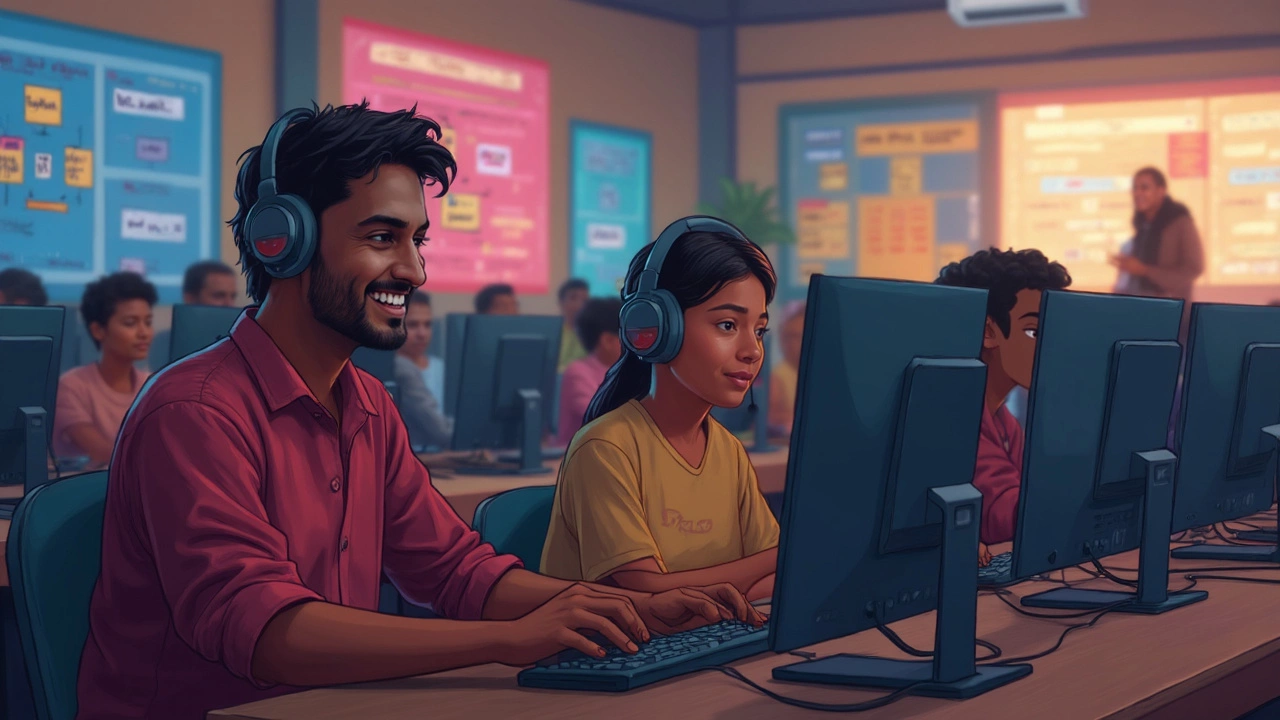So, you're thinking about learning to code but you're not sure which language to start with? You're definitely not alone. Coding can open up huge opportunities, but picking the wrong first language can leave you stuck before you really get going.
The good news: you don't have to spend weeks researching. A few popular languages stand out because they're easier to understand, have lots of resources for beginners, and are actually useful in real-world jobs. Some, like Python, read almost like plain English compared to old-school languages like C or Java. Others, like JavaScript, let you build cool stuff for the web from day one.
If you want to avoid common mistakes—like starting with a language that's too complex or not useful for your goals—knowing what makes a language beginner-friendly is key. Most people drop coding because their first steps feel impossible, not because they're bad at it. Picking a language that feels less like learning ancient math and more like solving fun puzzles makes a world of difference.
- Why Picking the Right Language Matters
- Top Programming Languages for Beginners
- How Each Language Fits Different Goals
- Tips for Starting Your Coding Journey
Why Picking the Right Language Matters
Choosing your first coding language isn’t just about what’s trendy. It's about how smoothly you can start, what you can actually build, and how likely you’ll stick with it. Beginners who pick a language that matches their goals and fits their learning style are more likely to keep going. That boost in confidence is a game changer.
Let’s be real: some languages throw tough concepts at you right away. Starting there makes learning code feel more like running into a wall than learning a new skill. Languages with easy-to-read syntax (the basic rules for writing code) and tons of beginner support help people make faster progress and avoid the usual frustration.
“Nearly 70% of people who give up on coding cite picking the wrong language or too steep a learning curve as the main reason.” — FreeCodeCamp
Picking the right language also makes sense if you care about job options. For example, Python and JavaScript are in huge demand. That means more jobs, more tutorials, bigger online communities, and more projects you actually care about.
Here’s a quick look at why the right beginner language makes such a big impact:
- Coding for beginners is way less intimidating with friendly syntax (like Python’s clear structure).
- You’ll find way more step-by-step guides and videos if you start with popular languages.
- If you run into trouble, you can ask for help and get answers fast from big online communities.
- Your projects feel meaningful sooner—you can build websites, games, or data charts instead of just “Hello, World.”
Check out how popular beginner-friendly languages stack up with real stats:
| Language | Stack Overflow Questions (2024) | Job Openings (US, May 2025) |
|---|---|---|
| Python | 2.6 million | 185,000+ |
| JavaScript | 2.1 million | 160,000+ |
| Java | 1.8 million | 120,000+ |
| Ruby | 450,000 | 25,000 |
Bottom line? The right pick means less frustration, lots of support, and skills that actually help you get where you want to go—whether that’s landing a job or building your dream app.
Top Programming Languages for Beginners
If you ask five seasoned developers which language is best for newbies, you’ll probably get five different answers. But a few languages keep topping the lists for one big reason—they make it way less painful to get started. Here’s a quick, no-nonsense look at the options actually worth your time when learning to code for the first time.
- Python – Seriously, nearly everyone recommends this one. Its syntax is clean and simple to read, almost like regular English, which makes it perfect for learning basics like variables and loops without fighting the language itself. Python powers websites, automates boring tasks, crunches data, and even runs behind AI and robotics projects. Instagram and Spotify both use Python, so you know it scales up. Tons of free tutorials exist, and you'll find endless beginner-friendly coding classes online.
- JavaScript – If you’re more interested in building web apps or interactive websites, JavaScript has no competition. All major browsers use it, and if you learn it, you see your results instantly in any web page. JavaScript is behind everything from simple contact forms to complex games and social media feeds.
- Scratch – Not a ‘real’ coding language in a job sense, but unbeatable if you’ve never coded or if you’re teaching kids. Scratch swaps typing for drag-and-drop code blocks, so you learn how logic works without ever worrying about weird punctuation mistakes. When your brain is comfortable with coding concepts, jumping to a text-based language gets a lot easier.
- Ruby – It’s dropped in popularity, but Ruby (and its Rails framework) is another easy option for beginners, especially if you like the idea of building websites. Ruby’s syntax feels very forgiving and friendly to new coders, and there’s a passionate support community if you hit a wall.
- HTML & CSS – Technically not programming languages, but if you want to see results instantly while building basic websites, don’t overlook these. They teach structure (HTML) and style (CSS) and fit nicely as a starter before tackling JavaScript or Python for bigger tasks.
Don’t stress if you’re not sure which one fits you best just yet. Most people start with Python or JavaScript and branch out as they go. The key is just to pick one and stick with it long enough to build something real. That’s how you build confidence in any coding for beginners class or journey.

How Each Language Fits Different Goals
Not every coding language is built for the same stuff. What you want to make should steer your choice a lot. Here’s a breakdown of some of the most common goals and which languages fit best.
- Python: This one’s like the Swiss Army knife for coding. If you're interested in data science, artificial intelligence, web apps, or even just automating boring tasks, Python is your best friend. People love it because the code looks clean and there’s a massive online community ready to help out beginners.
- JavaScript: If building websites pops up in your plans, you almost can’t skip JavaScript. It’s what makes those websites interactive—think buttons that actually do things or instant content updates. Want to build web apps? JavaScript is where you start, and it works hand-in-hand with HTML and CSS.
- Scratch: For absolute beginners or younger kids (think under 14), Scratch is a solid way to learn coding concepts through visual blocks. It’s not used in real jobs, but it absolutely helps build problem-solving muscles before moving to "real" coding.
- Java: If you’re looking at mobile app development for Android, or larger-scale software that runs everywhere, Java is worth learning. It’s a little more verbose (read: there’s more typing involved), but companies use it a lot, so it’s a solid option if you’d like a job later on.
Plenty of people want to know: what coding is best for beginners who eventually want to earn money? Here’s a cheat sheet showing a few language-goal combos so you don’t have to guess:
| Goal | Best Language(s) | Why? |
|---|---|---|
| Data Science / AI | Python | Easy to learn, tons of libraries, big community |
| Web Development | JavaScript | All browsers use it, interactive features, huge job market |
| Android Apps | Java, Kotlin | Official languages for Android, widely supported |
| Learning Basics (kids/total newbies) | Scratch | Visual, simple, helps build logic thinking |
It’s not about picking the "most popular" language—it’s about what actually gets you closer to what you want to build or do. Focus on where you want to end up, then pick the language that makes sense for that path. Makes the learning curve feel way less steep, trust me.
Tips for Starting Your Coding Journey
You don't need to be a math whiz or a young genius to start coding. The biggest trick is keeping it simple and practical from day one. Here are the best steps to kick things off and stick with it.
- Focus on the basics of coding for beginners before diving into fancy projects. Understanding how variables, loops, and functions work pays off with any language you pick.
- Pick one small project that actually excites you. This could be a calculator app, a simple website, or even a basic game. Making something real gives you fast feedback and keeps things interesting.
- Schedule short, regular practice sessions. Fifteen to thirty minutes a day works better than long, random marathons. You remember stuff more easily this way.
- Use free resources like Codecademy or freeCodeCamp. For Python, try the official docs or tutorials on YouTube. For JavaScript, Mozilla's MDN is a lifesaver for fast answers.
- If you get stuck, don’t waste hours alone—Google your problem, or ask in a beginner-friendly community like Stack Overflow or Reddit's r/learnprogramming.
If you like seeing quick results, share your code as you go. Try GitHub for free hosting and version control. Yes, it seems like a pro move, but beginners use it too. Employers often check candidate GitHub profiles for real projects, so it pays off later.
Learning to code often feels slow at first. Remember, even experienced developers spend 50% of their time debugging and Googling errors. It’s totally normal—nobody has it easy from the start.
| Activity | Time Spent (%) |
|---|---|
| Practicing basics (syntax, structures) | 30 |
| Debugging code | 25 |
| Following tutorials | 20 |
| Searching for answers online | 15 |
| Building projects | 10 |
Finally, set clear goals. Want to build a website, automate tasks, or land an entry-level job? Focus your learning path on what gets you excited. Keeping your target in mind helps filter out distractions and the never-ending sea of programming advice out there.

